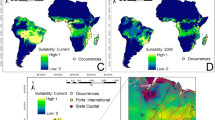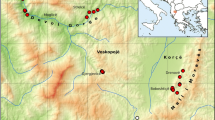Abstract
Eurylophella iberica Keffermüller and Da Terra, 1978 is an endemic insect species of the Iberian Peninsula whose distribution has been poorly studied to date with rather old and scattered records. Here we compiled all existing distribution records and add new records from recent sampling activities. We also used this updated distributional information and environmental data (climate and geology) to estimate both current and future potential distributions in different climate change scenarios. We found that currently ca. 50% of the total Iberian region could present suitable environmental conditions for E. iberica (all the Iberian Peninsula, save the most eastern and Mediterranean areas). However, the potential distributions estimated when considering future climate change scenarios showed a marked reduction in the areas with suitable environmental conditions for the species, especially in the south. The northwest part of the Iberian Peninsula is a crucial zone for the future survival of this endemic species. We also found that most populations that occur in areas with suitable (both current and future) environmental conditions fall outside the Natura 2000 network of protected areas. Our results represent the first attempt to estimate the potential distribution of this endemic species providing important insights for its conservation.



Similar content being viewed by others
References
Alba-Tercedor J (1981) Recopilación de citas de Efemerópteros en la Península Ibérica e Islas Baleares. Trab. Monogr. Dep. Zool Univ Granada 4(2):41–81
Alba-Tercedor J, Jáimez-Cuéllar P (2003) Checklist and historical evolution of the knowledge of Ephemeroptera in the Iberian Peninsula, Balearic and Canary Islands. In: Gaino E (ed). Research update on Ephemeroptera & Plecoptera. Università di Perugia, Perugia, pp 91–97
Alba-Tercedor J, Sáinz-Bariáin M, Poquet JM, Rodríguez-López R (2017) Predicting river macroinvertebrate communities distributional shifts under future global change scenarios in the Spanish Mediterranean Area. PLoS ONE 12(1):e0167904
Bauernfeind E, Soldán T (2012) The mayflies of Europe (Ephemeroptera). Apollo Books, Ollerup
Beaumont LJ, Hughes L, Poulsen M (2005) Predicting species distributions: use of climatic parameters in BIOCLIM and its impact on predictions of species’ current and future distributions. Ecol Model 186:250–269
Bonada N, Zamora-Muñoz C, Rieradevall M, Prat N (2005) Ecological and historical filters constraining spatial caddisfly distribution in Mediterranean rivers. Freshw Biol 50:781–797
Caissie D (2006) The thermal regime of rivers: a review. Freshw Biol 51:1389–1406
Calenge C, Darmon G, Basille M, Loison A, Jullien JM (2008) The factorial decomposition of the Mahalanobis distances in habitat selection studies. Ecology 89:555–566
Cheng W, Bonebrake TC (2017) Conservation effectiveness of protected areas for Hong Kong butterflies declines under climate change. J Insect Conserv 21:599–606. https://doi.org/10.1007/s10841-017-9998-7
Conti L, Schmidt-Kloiber A, Grenouillet G, Graf W (2014) A trait-based approach to assess the vulnerability of European aquatic insects to climate change. Hydrobiologia 721:297–315
D’Amen M, Bombi P, Campanaro A, Zapponi L, Bologna MA, Mason F (2013) Protected areas and insect conservation: questioning the effectiveness of Natura 2000 network for saproxylic beetles in Italy. Anim Conserv 16:370–378
Domisch S, Araújo MB, Bonada N, Pauls SU, Jähnig SC, Haase P (2013) Modelling distribution in European stream macroinvertebrates under future climates. Glob Change Biol 19:752–762
Etherington TR, Ward AI, Smith GC, Pietravalle S, Wilson GJ (2009) Using the Mahalanobis distance statistic with unplanned presence-only survey data for biogeographical models of species distribution and abundance: a case study of badger setts. J Biogeogr 36:845–853
Fenoglio S, Bonada N, Guareschi S, López-Rodríguez MJ, Millán A, Tierno de Figueroa JM (2016) Freshwater ecosystems and aquatic insects: a paradox in biological invasions. Biol Lett 12:20151075
Flato GM, Boer GJ, Lee WG, McFarlane NA, Ramsden D, Reader MC, Weaver AJ (2000) The Canadian centre for climate modelling and analysis global coupled model and its climate. Clim Dyn 16:451–467
Funk DH, Sweeney BW (1994) The larvae of eastern North American Eurylophella Tiensuu (Ephemeroptera: Ephemerellidae). Trans Am Entomol Soc 120:209–286
García Rojas AM, Ferreras Romero M (1995) El Rio Yeguas: Caracterización y calidad de sus aguas: factores físicos-químicos y biológicos (in Spanish). Diputación de Cordoba, Ayuntamiento de Cardeña. ISBN: 84-605-2806-5
GBIF Global Biodiversity Information Facility (2007) Free and open access to biodiversity data. http://www.gbif.org/. Accessed 18 May 2017
Gonzalez del Tánago M (1984) Contribution to the zoogeography of the Spanish Ephemeroptera. In: Landa V, Soldan T, and Tonner M (eds) Proceedings of the fourth international conference on Ephemeroptera, Bechyne, September 4–10, 1983 Institute of Entomology, Czechoslovak Academy of Sciences, Ceske Budejovice
Gonzalez del Tánago M, De Jalón DG (1983) New ephemerellidae from Spain (Ephemeroptera). Aquatic Insects 5:147–156
Guareschi S, Coccia C, Sánchez-Fernández D, Carbonell JA, Velasco J, Boyero L, Green AJ, Millán A (2013) How far could the alien boatman Trichocorixa verticalis verticalis spread? Worldwide estimation of its current and future potential distribution. PLoS ONE 8:e59757
Guareschi S, Bilton DT, Velasco J, Millán A, Abellán P (2015) How well do protected area networks support taxonomic and functional diversity in non-target taxa? The case of Iberian freshwaters. Biol Cons 187:134–144
Hijmans RJ, Cameron SE, Parra JL, Jones PG, Jarvis A (2005) Very high resolution interpolated climate surfaces for global land areas. Int J Climatol 25:1965–1978
Hirzel AH, Hausser J, Chessel D, Perrin N (2002) Ecological-niche factor analysis: how to compute habitat suitability maps without absence data? Ecology 83:2027–2036
Hortal J, de Bello F, Diniz-Filho JAF, Lewinsohn TF, Lobo JM, Ladle RJ (2015) Seven shortfalls that beset large-scale knowledge on biodiversity. Annu Rev Ecol Evol Syst 46:523–549
IPCC (2007) In: Solomon S, Qin D, Manning M, Chen Z, Marquis M, Averyt KB, Tignor M, Miller HL (eds) Climate change 2007: the physical science basis, contribution of working group I to the fourth assessment report of the intergovernmental panel on climate change. Cambridge University Press, Cambridge
Jiménez-Valverde A, Peterson AT, Soberon J, Overton J, Aragon P, Lobo JM (2011) Use of niche models in invasive species risk assessments. Biol Invasions 13:2785–2797
Joppa LN, Pfaff A (2009) High and far: biases in the location of protected areas. PLoS ONE 4:e8273
Keffermüller M, Da Terra LSW (1978) The second European species of the subgenus Eurylophella Tiensuu (Ephemeroptera, Ephemerellidae, Ephemerella). Bulletin de l’Académie Polonaise des Sciences. Série des Sciences Biologiques 26:29–33
Lomolino MV (2004) Conservation biogeography. In: MV Lomolino, Heaney LR (Eds) Frontiers of biogeography: new directions in the geography of nature. Sinauer Associates, Sunderland, pp 293–296
Márquez Rodríguez J (2015) Seguimiento plurianual de la fauna de macroinvertebrados en dos cursos de pequeño orden de Sierra Morena (Sevilla) tras un incendio forestal (in Spanish). PhD Thesis University Pablo de Olavide, Faculty of Experimental Sciences, Seville
Martínez-Sanz C, Cenzano CS, Fernández-Aláez M, García-Criado F (2012) Relative contribution of small mountain ponds to regional richness of littoral macroinvertebrates and the implications for conservation. Aquatic Conserv 22:155–164
Martynov AV, Palatov DM, Godunko RJ (2015) The larvae of West Palaearctic EurylophellaTiensuu, 1935 (Ephemeroptera: Ephemerellidae), with description of a new species from Georgia. Zootaxa 3904:123–143
Neff MR, Jackson DA (2011) Effects of broad-scale geological changes on patterns in macroinvertebrate assemblages. J N Am Benthol Soc 30:459–473
Pardo I, Eiroa E, Novoa F (1991) New records of mayflies from Galicia (Ephemeroptera): overview and strategies of Ephemeroptera and Plecoptera. Sandhill Crane Press, Gainsville, pp 289–296
Parmesan C, Yohe G (2003) A globally coherent fingerprint of climate change impacts across natural systems. Nature 421:37–42
Puig MA, García-Rojas AM, Ferreras-Romero M (1986) Efemerópteros nuevos para Andalucía. Boletín Asociacion Española de Entomología 10:404
Ramirez J, Jarvis A (2008) High resolution statistically downscaled future climate surfaces. http://ccafs-climate.org. Accessed 13 May 2017
Sampaio A, Cortes R, Leão C (2001) Invertebrate and microbial colonisation in native and exotic leaf litter species in a mountain stream. Int Rev Hydrobiol 86:527–540
Sánchez-Fernández D, Bilton DT, Abellán P, Ribera I, Velasco J, Millán A (2008) Are the endemic water beetles of the Iberian Peninsula and the Balearic Islands effectively protected? Biol Conserv 141:1612–1627
Sánchez-Fernández D, Lobo JM, Hernández-Manrique OL (2011) Species distribution models that do not incorporate global data misrepresent potential distributions: a case study using Iberian diving beetles. Diversity Distribution 17:163–171
Sánchez-Fernández D, Abellán P, Picazo F, Millán A, Ribera I, Lobo JM (2013) Do protected areas represent species’ optimal climatic conditions? A test using Iberian water beetles. Divers Distrib 19:1407–1417
Studemann D, &Tomka I (1987) Contribution to the study of European Ephemerellidae (Ephemeroptera): I. Completion of description of three endemic Iberian species. Mitteilungen der Schweizerischen Entomologischen Gesellschaft 60:361–378
Vannote RL, Minshall GW, Cummins KW, Sedell JR, Cushing CE (1980) River continuum concept. Can J Fish Aquat Sci 37:130–137
Vidal M, Membiela P (1994) Efemeropteros у Plecopteros (Insecta) de las Sierras Segundera, Cabrera у Teleno (NW de la Peninsula Iberica). Boletín Asociacion Española de Entomologia 18:49–64
Webb BW, Clack PD, Walling DE (2003) Water–air temperature relationships in a Devon river system and the role of flow. Hydrol Proces 17:3069–3084
Wilson RJ, Maclean IM (2011) Recent evidence for the climate change threat to Lepidoptera and other insects. J Insect Conserv 15:259–268
Acknowledgements
Sampling campaigns 2016–2017 were undertaken as part of the Project “Explotación de los programas de control y seguimiento de los elementos de calidad biológicos e hidromorfológicos en las aguas continentales superficiales en la Cuenca Hidrográfica del Guadalquivir”, carried out by DBO5 S.L. (environmental firm, Seville). Thanks go to the “Confederación Hidrográfica del Guadalquivir” (Área de Calidad de Aguas) for its support and help. Thanks to Maria Jesus Serrano, Carmen Ruiz-Delgado, Adrian Ramos and Félix Picazo for their help with laboratory and field works and Helen Warburton for checking the English grammar. The authors also wish to thanks anonymous reviewers for input and useful suggestions. DS-F was supported by a post-doctoral contract funded by the Universidad de Castilla-La Mancha and the European Social Fund (ESF).
Author information
Authors and Affiliations
Corresponding author
Ethics declarations
Conflict of interest
No potential conflict of interest is reported by the authors.
Electronic supplementary material
Below is the link to the electronic supplementary material.

10841_2018_44_MOESM1_ESM.jpg
Map of the Eurylophella iberica records throughout the Iberian Peninsula (39 records). New records from this paper (first-time published) are displayed as red points. (JPG 199 KB)
Rights and permissions
About this article
Cite this article
Guareschi, S., Mellado-Díaz, A., Puig, M.Á. et al. On the Iberian endemism Eurylophella iberica Keffermuller and Da Terra 1978 (Ephemeroptera, Ephemerellidae): current and future potential distributions, and assessment of the effectiveness of the Natura 2000 network on its protection. J Insect Conserv 22, 127–134 (2018). https://doi.org/10.1007/s10841-018-0044-1
Received:
Accepted:
Published:
Issue Date:
DOI: https://doi.org/10.1007/s10841-018-0044-1




